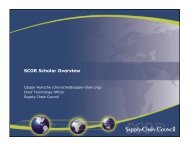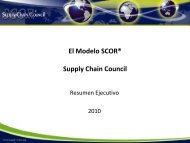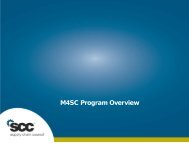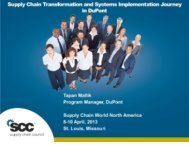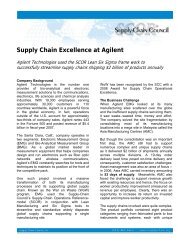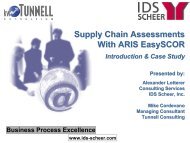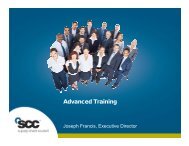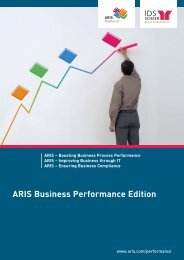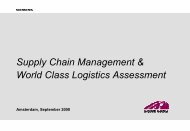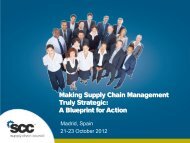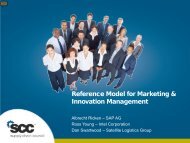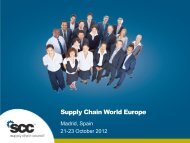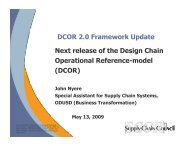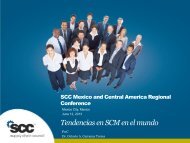Value Chain Transformation - An Introduction - Supply Chain Council
Value Chain Transformation - An Introduction - Supply Chain Council
Value Chain Transformation - An Introduction - Supply Chain Council
Create successful ePaper yourself
Turn your PDF publications into a flip-book with our unique Google optimized e-Paper software.
Consulting<br />
<strong>Value</strong> <strong>Chain</strong> <strong>Transformation</strong><br />
- <strong>An</strong> <strong>Introduction</strong><br />
Business Consulting, PwC LLP<br />
Strictly Private<br />
and Confidential<br />
09 November 2011<br />
PwC
Agenda<br />
• Key challenges in growth in Asia Pacific Region<br />
• <strong>Introduction</strong> to <strong>Value</strong> <strong>Chain</strong> <strong>Transformation</strong> (“VCT”)<br />
• VCT business models and Transform Methodologies<br />
• Case Study<br />
• PwC Business Consulting Services<br />
• Questions and Discussion<br />
PwC<br />
2
Based on historic, adhoc growth, many Euro & US companies are<br />
operating decentralised models for their Asia businesses<br />
Transfer Pricing<br />
Cost Plus<br />
Goods<br />
China, Malaysia and Taiwan<br />
Manufacturers<br />
Revenue Centre<br />
• Manufacturing<br />
• R&D<br />
• Demand planning/<br />
procurement<br />
• <strong>Supply</strong> planning<br />
• Shipping and logistics<br />
Services<br />
• Limited central supply chain oversight<br />
• Limited centralized demand planning<br />
• Limited central relationship with suppliers<br />
Singapore<br />
RHQ<br />
Cost Centre<br />
• Regional management<br />
• Regional marketing<br />
• Regional design<br />
• Regional finance/tax<br />
• Regional treasury<br />
Services<br />
• Decentralized IP Management<br />
• Decentralized treasury function<br />
Korea/China/Mal/Japan<br />
Sales Office<br />
• Sales<br />
Revenue Centre<br />
• Volumes<br />
• Customer relationships<br />
• Demand planning<br />
• Operational cost of Sales Co<br />
• After sales service<br />
• Decentralized control over regional tax and customs risks<br />
PwC<br />
3
A decentralized APAC structure resulted in multiple <strong>Supply</strong> <strong>Chain</strong><br />
challenges<br />
Suppliers Manufacturing –CM S1 Manufacturing –CM S2 Warehousing Sales Co<br />
Customer<br />
Materials SF Goods F Goods<br />
Planning / <strong>Supply</strong> mgt<br />
Duplications<br />
Complex compliance mgt<br />
PwC<br />
Inventory<br />
DTP<br />
Material Flow<br />
Information Flow<br />
Legal / Invoicing Flow<br />
Mix of systems<br />
Physical footprint driven<br />
Regional leveraging<br />
Terms<br />
4
In response to the challenges and risks, companies are electing to<br />
implement a regional hub company structure<br />
TP1<br />
Cost Plus<br />
TP2<br />
Resale Minus<br />
Goods<br />
Goods<br />
China, Malaysia and Taiwan<br />
Manufacturers<br />
PwC<br />
Cost Centre<br />
• Manufacturing<br />
• R&D<br />
• Demand planning<br />
• <strong>Supply</strong> planning<br />
• Shipping and logistics<br />
Singapore<br />
RHQ<br />
Revenue Centre<br />
• Regional management<br />
• Regional marketing<br />
• Regional design<br />
• Regional finance/tax<br />
• Regional treasury<br />
• Regional demand planning<br />
• Regional supply planning<br />
• Regional shipping and logistics<br />
• Customer relationships<br />
Korea/China/Mal/Japan<br />
Sales Office<br />
• Sales<br />
Revenue Centre<br />
• Volumes<br />
• Customer relationships<br />
• Demand planning<br />
• Operational cost of Sales Co<br />
• After sales service centre<br />
5
Agenda<br />
• Key challenges in growth in Asia Pacific Region<br />
• <strong>Introduction</strong> to <strong>Value</strong> <strong>Chain</strong> <strong>Transformation</strong> (“VCT”)<br />
• VCT business models and Transform Methodologies<br />
• Case Study<br />
• PwC Business Consulting Services<br />
• Questions and Discussion<br />
PwC<br />
6
<strong>Value</strong> <strong>Chain</strong> <strong>Transformation</strong> (VCT) looks at how a company does business,<br />
from strategy to customer delivery, in an optimised manner<br />
Basic VCT concepts:<br />
Structuring/restructuring a company’s Asia regional operations and footprint to<br />
optimise the value chain , aligned to tax and customs structures.<br />
1. Centralising: high value functions which drive execution of strategy & creation of<br />
value; business controls, risk and intangibles (IP)<br />
• profits are aligned with functions, risks and intangibles<br />
2. Locating the centralised, new structure in a jurisdiction where tax position is best<br />
managed and the customs position is optimised<br />
• re-alignment accompanies business change<br />
• The primary focus is optimising the value chain<br />
3. Simplifying in-country operations to focus on responding to local requirements, by<br />
centralising functions and reducing duplication of activities<br />
This involves centralising high value functions and aligning with tax and<br />
customs structures<br />
PwC<br />
7
Achieving supply chain improvement through process and organisational<br />
re-design<br />
Shared<br />
Service<br />
Finance, HR<br />
Reduction in open account<br />
receivables beyond term<br />
Planning<br />
Opportunities<br />
Consolidated planning<br />
Inventory reduction<br />
IPO Centralized procurement ><br />
leverage & payables, Extended IPO<br />
to non GC items<br />
Scalable structure<br />
Up & down scalability<br />
Increased focus on supplier<br />
delivery performance<br />
Upside/downside supply chain<br />
flexibility<br />
Best Practice<br />
Driving Best practice in<br />
Contractual, Distribution,<br />
Sales & pricing<br />
PwC<br />
More control on delivery to<br />
promise performance<br />
8
... and maximising financial value creation by leveraging low taxation<br />
jurisdictions<br />
In addition to operational savings, it is critical for companies to consider the tax impact of<br />
their business model<br />
50%<br />
Incentivised Portion<br />
Corporate Tax Rate<br />
Decentralised Model<br />
45%<br />
40%<br />
35%<br />
30%<br />
25%<br />
20%<br />
15%<br />
10%<br />
5%<br />
VCT<br />
Reduction in ETR from<br />
approximately 30% to
This approach requires a comprehensive review of how the business<br />
operates<br />
Suppliers<br />
Order processing / central<br />
procurement / central treasury<br />
Raw Materials<br />
Information<br />
Management<br />
Shared Service Center<br />
/ Call Center<br />
Manufacturing<br />
Finished Goods<br />
Material Flow<br />
Information Flow<br />
Legal / Invoicing Flow<br />
Payment / Supplier<br />
Management<br />
Production<br />
Scheduling<br />
Warehousing<br />
Regional<br />
Headquarters<br />
Delivery<br />
Instructions<br />
Finished Goods<br />
Distribution<br />
Network<br />
Demand plans /<br />
Orders<br />
Finished Goods<br />
Invoicing<br />
Sales Offices<br />
Orders<br />
Customers<br />
PwC<br />
10
VCT can bring changes to all areas of the organisation<br />
Organisation Structure<br />
•Changes in organisational<br />
responsibilities<br />
•<strong>Introduction</strong> of new roles, particularly<br />
in oversight<br />
•Mandated activities at the Hub/<br />
Principal<br />
Process<br />
• May be driven by regulatory<br />
environment –not necessarily the<br />
most elegant solution<br />
• Some duplication –e.g. Billing<br />
• Changes to control points<br />
PwC<br />
People<br />
•Changes in roles and responsibilities<br />
•Possible changes in location<br />
•New or varied skill sets<br />
•New performance measures<br />
Technology and Systems<br />
• Expanded data requirements<br />
• Systems changes<br />
• Workflow<br />
• Approvals<br />
• Reporting<br />
• Interfaces with Customer and<br />
Supplier systems<br />
11
Agenda<br />
• Key challenges in growth in Asia Pacific Region<br />
• <strong>Introduction</strong> to <strong>Value</strong> <strong>Chain</strong> <strong>Transformation</strong> (“VCT”)<br />
• VCT business models and Transform Methodologies<br />
• Case Study<br />
• PwC Business Consulting Services<br />
• Questions and Discussion<br />
PwC<br />
12
Potential models for international transactions to be used in Asia (export<br />
business)<br />
1. Procurement/Services Hub –procures raw materials / products on behalf of the group<br />
manufacturing / sales companies<br />
2.IP Hub –owns IP and takes all costs and risks associated with its development.<br />
3.Trading Hub –buys product from manufacturers, holds inventory title, and sells it to sales<br />
companies at own risk. It takes inventory holding/obsolescence risk, FX risk, credit risk, warranty<br />
risk (epidemic failures relating design/manufacturing) and marketing risk.<br />
4.Full Principal –takes supply planning risk, supplier quality and some procurement risks, as well<br />
as all the Trading Hub risks mentioned in above point 2.<br />
PwC<br />
13
Trading (buy/sell) hub provides higher levels of benefits while requiring<br />
organisational and process changes<br />
Manufacturers<br />
in Asia Pacific<br />
1. Sales of<br />
finished<br />
products<br />
Singapore<br />
Trading Hub<br />
Manufacturers<br />
outside Asia Pacific<br />
/ Third-party<br />
manufacturers<br />
2. Sales of<br />
finished<br />
products<br />
Notes<br />
• This model changes the sales companies in the region to<br />
limited risk distributors<br />
• The manufacturing companies continue to be full fledged<br />
manufacturers<br />
• The LRDs source all their products from a central hub in<br />
Singapore and sell to final customers on a limited risk basis<br />
Issues to consider<br />
• Transfer pricing issues<br />
• Exit tax implications in the sales companies’countries<br />
• Customs and VAT impact<br />
• Substance required in Hub<br />
• Operational and functional impact<br />
• IT systems changes<br />
• Change management<br />
3. Sales of<br />
finished<br />
products<br />
LRDs in Asia Pacific<br />
Benefits<br />
• Options to achieve simplified transaction flows<br />
• Centralised demand planning and supply planning<br />
• Customs and trade planning<br />
• Control on majority of the risks within the group relating to<br />
the sales side<br />
• Potentially lower effective tax rate<br />
PwC<br />
14
Full Principal provides the most benefits and faces stricter substance<br />
requirements<br />
Contract<br />
Manufacturers<br />
in Asia Pacific<br />
Manufacturers<br />
outside Asia Pacific<br />
/ Third-party<br />
manufacturers<br />
Notes<br />
• This model is an extension of the trading hub<br />
• The manufacturers in Asia in this case are converted to<br />
contract manufacturers<br />
1. Sales of<br />
finished<br />
products<br />
Singapore Manufacturing<br />
Control Entity<br />
3. Sales of<br />
finished<br />
products<br />
LRDs in Asia Pacific<br />
2. Sales of<br />
finished<br />
products<br />
Issues to consider<br />
• Transfer pricing implications<br />
• Exit tax issues in manufacturing companies’countries<br />
• Customs and VAT impact<br />
• Substance requirement<br />
• Operational and functional impact<br />
• IT systems changes<br />
• Change management<br />
Benefits<br />
• Centralised business model leading to control<br />
• Economies of scale<br />
• Regional demand and supply planning<br />
• Optimised production scheduling<br />
• Possibility to lower the effective tax rate even further<br />
PwC<br />
15
Step by Step centralisation approach based on change capabilities, risks,<br />
and benefits<br />
R&D Service Providers<br />
Singapore China<br />
(C) Manufacturers / Suppliers<br />
IP Centralisation<br />
Provision of<br />
contract R&D<br />
services<br />
Buy Sell Principal<br />
for Asian<br />
Manufacturers<br />
Available Operating Models:<br />
Regional SC in Principal<br />
IP Principal<br />
Buy-Sell Principal<br />
LRDs<br />
Full Principal<br />
LRDs in Asia<br />
Pacific<br />
Taiwan China Philippines<br />
Malaysia Korea Singapore<br />
Manufacturers / Suppliers<br />
Rest of World<br />
Provision of contract<br />
manufacturing services<br />
Buy Sell Principal<br />
for Rest of World<br />
sourcing<br />
Sales Companies in<br />
Rest of World<br />
PwC<br />
16
Agenda<br />
• Key challenges in growth in Asia Pacific Region<br />
• <strong>Introduction</strong> to <strong>Value</strong> <strong>Chain</strong> <strong>Transformation</strong> (“VCT”)<br />
• VCT business models and Transform Methodologies<br />
• Case Study<br />
• PwC Business Consulting Services<br />
• Questions and Discussion<br />
PwC<br />
17
Case Study 1 - US-based High Technology contract manufacturer<br />
• Multi-billion dollar annual turnover<br />
• Manufacturing in Asia, North and South America, Europe<br />
• Business growth primarily in Asia<br />
• High level of control by end Customer<br />
• Customer drives material choices<br />
• Highly competitive, low margin business<br />
• Many key customers already operate under a Principal model<br />
Major focus is to maintain customer service standards while driving<br />
operational, procurement and tax benefits<br />
PwC<br />
18
Case - Before<br />
PwC<br />
19
Case - After<br />
Materials<br />
Suppliers<br />
Principal<br />
•Contractual relationship with Customer<br />
•Contractual relationship with Suppliers<br />
•Carries risk<br />
•Adds value<br />
•Materials<br />
•<strong>Supply</strong> <strong>Chain</strong><br />
•Footprint planning<br />
•Market intelligence<br />
•Financing<br />
$/Invoice/Sell<br />
Material<br />
Buy at<br />
Cost<br />
FG sale:<br />
Cost plus<br />
Service<br />
fee<br />
Shared Service<br />
Centre*<br />
* Shared Service Centre provides<br />
services and support relating to<br />
processes to both the materials<br />
suppliers and the Principal.<br />
Receives a cost-plus service fee.<br />
Plant<br />
Product<br />
•Contract manufacturer<br />
•<strong>Value</strong> add from manufacturing<br />
•No value add on materials<br />
•Limited risk<br />
Customer<br />
PwC<br />
20
Case Study 2 - Global leader in specialised steel & industrial products<br />
•Configured as a Global manufacturer with sales units in many countries<br />
•Growth by acquisition as well as expansion –fragmented structures in Asia<br />
•Existing Principal structure in operation in Europe<br />
•Aim to leverage as much as possible of their European experience<br />
Asia Principal model designed around Sales function only –design aims to<br />
drive harmonisation and consistency in approach across the region<br />
PwC<br />
21
Case 2<br />
Before<br />
After<br />
Global HQ/<br />
Plant<br />
Global HQ/<br />
Plant<br />
Principal<br />
$/Invoice/Sell<br />
Product<br />
$/Invoice/Sell<br />
$/Invoice/Sell<br />
Country Sales<br />
Unit<br />
Country Sales<br />
Unit<br />
Product<br />
$/Invoice/Sell<br />
$/Invoice/Sell<br />
Customer<br />
Product<br />
Customer<br />
PwC<br />
•Global Business sells to the Singapore Principal<br />
•Singapore Principal sells to the customers in the<br />
local country in Asia Pacific.<br />
•Goods ordered are shipped directly by the Global<br />
Business to the customers.<br />
•Local Sales Units provide sales support services<br />
to the Singapore Principal<br />
22
Critical success factors<br />
Strategy<br />
Definition of roles and responsibilities<br />
Process<br />
Adequate resources–at all levels<br />
People<br />
HR management to maintaining critical<br />
project resource and motivation<br />
Structuring<br />
Constant and consistent communication<br />
flow to all involved parties<br />
Tax and Legal<br />
Hard link of tax and legal from the beginning<br />
Complete understanding of objectives, flows,<br />
processes, structure across the streams<br />
Technology<br />
Understanding of IT implications,<br />
tradeoffs, and willingness to resolve<br />
systems issues<br />
PwC<br />
23
Agenda<br />
• Key challenges in growth in Asia Pacific Region<br />
• <strong>Introduction</strong> to <strong>Value</strong> <strong>Chain</strong> <strong>Transformation</strong> (“VCT”)<br />
• VCT business models and Transform Methodologies<br />
• Case Study<br />
• PwC Business Consulting Services<br />
• Questions and Discussion<br />
PwC<br />
24
PwC’s scope of services for VCT assignments<br />
With recent acquisitions:<br />
We offer a full range of services to support <strong>Value</strong> <strong>Chain</strong> <strong>Transformation</strong>:<br />
Operations<br />
Driving the performance of<br />
regional supply chains<br />
Technology<br />
Trusted advisory to the CIO<br />
Shared services<br />
Driving efficiency and excellence<br />
in service delivery<br />
People & change<br />
Caring for the human side of<br />
transformation<br />
The consulting services we offer<br />
•<strong>Value</strong> chain transformation<br />
•Working capital optimisation (inventory and WIP)<br />
•<strong>Supply</strong> chain design and implementation<br />
•Business process improvement and rationalisation<br />
• Back office process optimisation<br />
− Includng financial reporting<br />
•System selection and implementation (ERP, CRM, BI)<br />
•Project management office (PMO) for IT projects<br />
•Project quality review before/ during/ after project<br />
•Assessment, design and implementation of IT controls<br />
•Data management / data quality<br />
•Optimising the value from IT spend<br />
•Improving IT service delivery<br />
•SSC strategy, design and implementation<br />
•Location study and assistance<br />
•Enhanced service delivery model<br />
•Communications and training<br />
•Stakeholder alignment<br />
•Organisation design<br />
Tax<br />
Transfer<br />
pricing<br />
The tax services we offer<br />
•Corporate tax and international tax advisory<br />
services<br />
•Tax efficient structuring<br />
•Corporate tax compliance<br />
•Effective supply chain transformation<br />
•Transfer pricing controversy and dispute<br />
resolution<br />
•Transfer pricing documentation<br />
The trade and customs services we offer<br />
Worldtrade<br />
Management<br />
Services<br />
•Customs value determination, optimization,<br />
and support<br />
•Leveraging of Free Trade Agreements for<br />
cost savings<br />
•Import/export regulatory impact of new<br />
trading structures<br />
•Import / export compliance controls and<br />
procedures<br />
•Duty minimization strategy<br />
•Export controls over “dual use”products<br />
PwC<br />
25
PwC offers a structured approach to deliver the benefits of <strong>Value</strong> <strong>Chain</strong><br />
<strong>Transformation</strong><br />
PwC<br />
1. Assess<br />
Opportunity<br />
Solutions<br />
Focus group on<br />
range of<br />
alternatives with<br />
client key<br />
stakeholders<br />
Activities<br />
Key Deliverables<br />
•High-level benefit<br />
and cost analysis<br />
for multiple<br />
restructuring<br />
scenarios<br />
Key Decisions<br />
Agree shortlist<br />
operating models<br />
Timeline (indicative only)<br />
2. Define<br />
Concept<br />
Provide shortlist<br />
of target operating<br />
models<br />
•Design and<br />
business case for<br />
shortlisted<br />
scenarios<br />
Agree preferred<br />
operating model(s)<br />
3. Design and<br />
Plan<br />
4. Implement 5. Support<br />
Optional: multiple roll-outs across business<br />
units<br />
Develop and Implement single preferred operating model or<br />
alternate operating models for different situations<br />
•Definitive legal and<br />
tax guidance<br />
•Detailed process,<br />
org & IT design<br />
•Detailed<br />
implementation<br />
plan<br />
Agree to start<br />
implementation<br />
•Business transition<br />
to new structure<br />
according to rollout<br />
plan<br />
Agree to<br />
go-live<br />
•Resolution of daily<br />
issues<br />
•Post<br />
implementation<br />
review<br />
10 weeks 12 weeks 10 weeks 12 weeks 8 weeks<br />
26
Agenda<br />
• Key challenges in growth in Asia Pacific Region<br />
• <strong>Introduction</strong> to <strong>Value</strong> <strong>Chain</strong> <strong>Transformation</strong> (“VCT”)<br />
• VCT business models and Transform Methodologies<br />
• Case Study<br />
• PwC Business Consulting Services<br />
• Questions and Discussion<br />
PwC<br />
27
Thank you<br />
The information contained in this presentation is of a general nature only. It is not meant to be comprehensive and does not constitute legal or tax advice.<br />
PricewaterhouseCoopers ("PwC") has no obligation to update the information as law and practice change. The application and impact of laws can vary widely based<br />
on the specific facts involved. No reader should act or refrain from acting on the basis of any material contained in this presentation without obtaining advice specific<br />
to their circumstances from their usual PwC client service team or their other advisers. The materials contained in this presentation were assembled in November<br />
2010 and were based on the law enforceable and information available at that time.<br />
© 2011 PricewaterhouseCoopers. All rights reserved. “PricewaterhouseCoopers”refers to the network of member firms of PricewaterhouseCoopers<br />
International Limited, each of which is a separate and independent legal entity.<br />
PwC<br />
28



